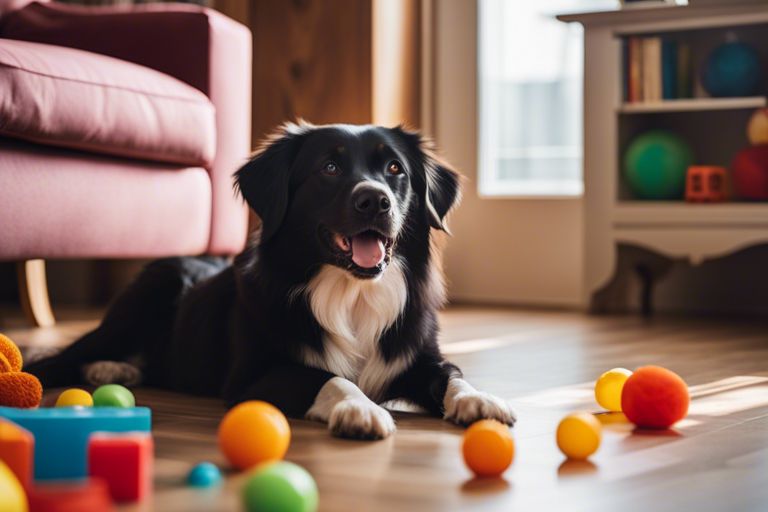Introducing your canine companion to the world of playthings can be a daunting task, but with the right approach, it can be an enjoyable and rewarding experience for both you and your furry friend. Many dog owners struggle with getting their pets to engage with toys, often due to lack of proper guidance in the training process. However, with patience, consistency, and the right techniques, you can successfully teach your dog to play with toys. In this blog post, we will explore effective methods for introducing and encouraging toy play, common mistakes to avoid, and the benefits of engaging your dog in interactive play. Whether you have a young pup or an older dog, these strategies can help foster a strong bond between you and your pet, while also providing mental stimulation and physical exercise.
Table of Contents
Key Takeaways:
- Choose the right toys: Select toys that are appropriate for your dog’s size, age, and breed to ensure safety and enjoyment.
- Introduce the toys properly: Show your dog the toy, engage their interest, and encourage them to interact with it using treats or praise.
- Use positive reinforcement: Reward your dog with treats or praise whenever they show interest in or play with the toy to reinforce the behavior.
- Play with your dog: Set aside dedicated playtime with your dog to demonstrate how to interact with the toy and to strengthen your bond with them.
- Be patient and consistent: Teaching your dog to play with toys may take time, so be patient and consistent in your training to achieve success.
Choosing the Right Toys for Your Dog
Obviously, the first step in teaching your dogs to play with toys is to choose the right ones for them. Not all dogs have the same preferences when it comes to toys, so it’s important to consider their individual needs and interests.
Understanding Your Dog’s Interests
Interests are an important factor to consider when selecting toys for your dogs. Some dogs may prefer plush toys that they can chew on, while others may be more interested in interactive toys that stimulate their minds. It’s important to observe your dogs to understand what types of toys they are naturally drawn to.
The Role of Toy Varieties and Textures
Role of toy varieties and textures cannot be understated when it comes to keeping your dogs engaged. Offering a variety of toys with different textures and shapes can help to keep your dogs interested and engaged. Some dogs may prefer rubber toys, while others may enjoy toys with crinkly or squeaky textures.
To ensure that your dogs stay entertained and engaged with their toys, it’s important to provide a range of options that cater to their individual interests and preferences. By offering a variety of toy types and textures, you can keep your dogs mentally and physically stimulated, promoting their overall well-being.
Basic Training Techniques to Encourage Play
Any dog can learn to play with toys, but it may require some training and patience on the part of the owners. By using basic training techniques, owners can encourage their dogs to engage with toys and enjoy playtime. Here are some effective methods to consider when teaching your dogs to play with toys.
Creating Positive Associations
Play should be a positive experience for your dogs. Start by introducing them to different toys in a calm and encouraging environment. Use treats and praise to create positive associations with the toys. When a dog shows interest in a toy, reward them with a treat and verbal praise. Gradually, they will begin to associate toys with positive experiences and will be more likely to engage with them during playtime.
One important aspect of reward-based training is to be consistent with the rewards you offer. When a dog engages with a toy, immediately provide a reward to reinforce the behavior. Over time, they will learn that playing with toys leads to positive outcomes, and they will be more motivated to continue playing. Plus, this method helps strengthen the bond between the dogs and their owners, as they learn to trust that positive behavior will be rewarded.
Enhancing Toy Engagement
Despite your efforts, some dogs may still need a little extra encouragement to engage with their toys. Fortunately, there are several strategies you can use to enhance their interest and enjoyment in playing with toys.
Interactive Games and Toys
On top of traditional toys, consider introducing interactive games and toys that require your dogs’ participation. Toys that dispense treats or have hidden compartments for your dogs to discover can be particularly engaging. An example of such a toy is a puzzle feeder, where dogs have to figure out how to access the treats hidden inside. These types of toys not only provide mental stimulation but also foster a greater bond between you and your dogs as they learn to seek your guidance and approval.
Rotation and Novelty to Maintain Interest
Engagement can wane if dogs are exposed to the same toys day after day. To maintain their interest, consider rotating their toys regularly and introducing new ones periodically. Interactive, sensory-stimulating toys with different textures, sounds, and scents can pique their curiosity and keep them engaged for longer periods of time. This also prevents boredom and decreases the likelihood of destructive behavior in dogs when they’re left alone.
By implementing these strategies, you can optimize the stimulation and engagement your dogs experience with their toys, keeping them mentally and physically healthy and engaged for hours on end. Remember to observe your dogs’ preferences and adjust their toys and games accordingly to ensure a positive and enriching experience for them.
Troubleshooting Common Issues
For more in-depth guidance on getting your dogs interested in toys and playing fetch, check out How to Get Your Dog Interested in Toys & Playing Fetch.
Overcoming Toy Aversion
Common issues with dogs not playing with toys include fear or discomfort with certain toys or lack of exposure to them. If your dogs are showing signs of aversion, start by introducing a variety of toys in different textures, shapes, and sizes. Encourage play by using positive reinforcement, such as treats or praise, to associate toys with rewards. It may also help to engage in interactive play with your dogs to show them how toys can be fun and enjoyable.
Addressing Destructive Behaviors
Common destructive behaviors in dogs, such as chewing or tearing apart toys, can be a result of excess energy or boredom. To address these issues, ensure that your dogs are getting adequate physical and mental exercise through regular walks, play sessions, and puzzle toys. Additionally, supervise your dogs during playtime to redirect any destructive behavior and to teach them appropriate ways to interact with their toys.
Plus, consider providing toys specifically designed for heavy chewers or puzzle toys to keep your dogs engaged and mentally stimulated, reducing the likelihood of destructive behaviors.
Conclusion
On the whole, teaching your dog to play with toys is an important part of their mental and physical well-being. By utilizing positive reinforcement techniques, using engaging and interactive toys, and being patient and consistent, you can effectively train your dog to enjoy playtime with toys. It is essential to understand your dog’s individual preferences and provide them with appropriate toys that cater to their needs and instincts. With time and effort, your dog can learn to associate toys with fun and can benefit from the mental stimulation and physical activity that playtime provides. By following these tips and being committed to the process, you can help your dog develop a healthy and enjoyable relationship with toys.
FAQ: Teaching Your Dog to Play with Toys
Q: Why is it important to teach your dog to play with toys?
A: It is important to teach your dog to play with toys as it provides mental and physical stimulation, helps in reducing boredom and anxiety, and strengthens the bond between you and your pet.
Q: How can I teach my dog to play with toys?
A: Start by selecting a variety of toys that are safe for your dog, then introduce them to your dog one at a time. Encourage play by using treats or praising them when they engage with the toy. Gradually increase the difficulty level by incorporating interactive toys or games such as fetch or tug-of-war.
Q: What should I do if my dog shows no interest in playing with toys?
A: If your dog shows no interest in playing with toys, try to observe what type of toys they are more drawn to and adjust accordingly. Some dogs may prefer certain textures or types of toys over others. Additionally, consider consulting with a professional dog trainer or behaviorist who can provide personalized guidance on how to encourage your dog to play with toys.











Add comment